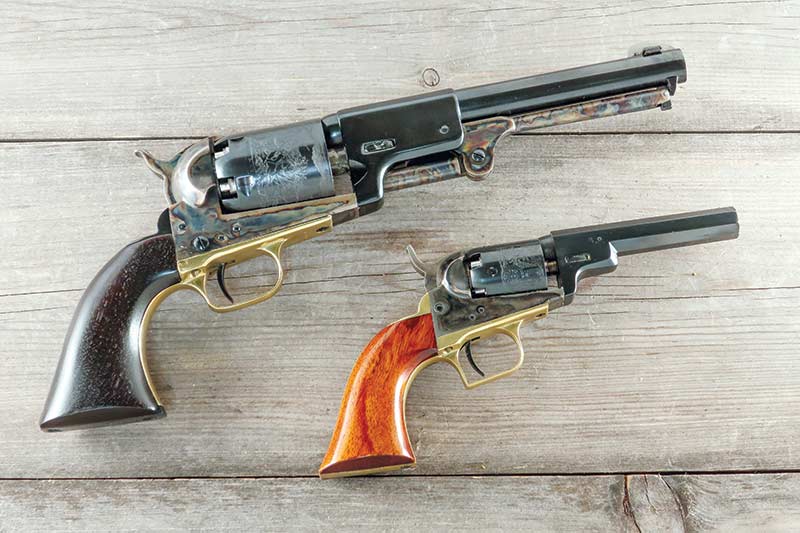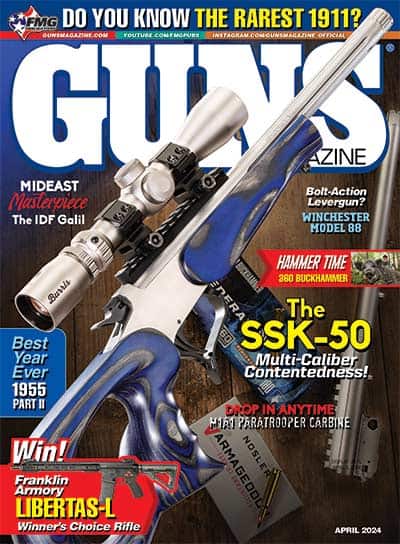BP Conicals and Pocket Pistols
These Babies Pack A Punch!
Sam Colt did not invent the revolver, but his Paterson in 1836 was the first successful repeating pistol. It was fragile and underpowered compared to the single-shot pistols of the time, however. Suddenly, high-capacity had arrived. Imagine being a Texas Ranger or member of the Texas Militia and having your single-shot rifle and single-shot pistol replaced by a pair that now delivered 10 quick shots. At close range, combatants on horseback became a formidable foe. The first practical sixgun was a success!
City Folks
Shortly thereafter, Sam Colt began to look at the needs of the civilian population. The result was the Pocket Models. Concealed carry with all its pocket pistols available today is not a new phenomenon. In spite of the movies, everyone in the old West did not walk around carrying a sixgun. Many towns actually had restrictions against such open carry. What was needed was an easily concealed revolver and Sam Colt’s answer was the .31 Pocket Models. They became the choice hideout guns for good guys and bad guys alike and could bring $100 in gold or more on the California goldfields.
Today replica Colt Pocket Models are available in three versions, namely the 1848 Wells Fargo, the 1849 Baby Dragoon and the 1849 Pocket Model. The first two do not have loading levers and must be loaded off the revolver, while the latter does have a loading lever. Although it is called the 1849 Pocket Model, it was produced in 1850, which is also the same year for the introduction of the 1851 Navy. Again the movies notwithstanding, Dragoons were carried in pommel holsters so the horse could carry all the weight. The 1851 Navy became the first practical belt pistol carried on the body and the Pocket Models became Colt’s most popular percussion sixgun. In 1862 Colt added .36 caliber pocket pistols to the lineup with the introduction of the Pocket Police and Pocket Navy. These are also now available in replica form.
To come up with the 1862 Pocket Models, Colt did the same thing they had done in going from the 1851 Navy .36 to the 1860 Army .44. That is, they made the front of the cylinder larger in diameter and cut a step in the top of the frame to accept it. This is what they did with the .31 Pocket Pistols to come up with .36 caliber versions. The .31 Pocket Models were produced for only 23 years from 1850 to 1873 while the .36 Pocket Models lasted only a little over 10 years. In this time, over 325,000 Pocket Model .31s were produced along with just under 40,000 .36 Pocket Police and Pocket Navy Models. The Colt Single Action in what we now know as the 1st Generation versions were produced from 1873 until 1940, or over 65 years and the production total was under 360,000. So in slightly more than one third of the time, the Pocket Models outproduced the Colt Single Action Army.
In addition to replica .31 Pocket Models being available, we can also choose from the 1862 Pocket Police and the 1862 Pocket Navy, both in .36 caliber and available in barrel lengths of 4 ½”, 5 ½” and 6 ½”. I have only seen the .31 versions available with 4″ barrels. I have acquired extra barrels from VTI Gun Parts and had them reduced in length to under 3″ to provide an even easier-to-conceal Percussion Pocket Model.
All of the replicas being produced follow the original pattern of very short front sights causing aimed fire to place bullets from 6″ to 8″ high or even higher. I have replaced all the front sights on my .31 Pocket Model and .36 Pocket Police and Pocket Navy Models with Remington front sights from VTI. These are set in a dovetail so they can be adjusted for windage and tall enough they can be filed down to adjust elevation.
Makin’ Smoke
In both the .31 and .36 Pocket Models I use round balls as well as conical bullets. For the latter I go with the original designs from Eras Gone Bullet Molds. For the .31 I use their 80-grain Baby Dragoon while the .36 Models are used with the 127-grain .36 Colt Cartridge Works bullet. Often with conical bullets, replica percussion pistols are not cut out properly in the loading port to allow conical bullets to rotate and be seated by the loading lever. This is not the case with the Pocket Models as the 1849 and 1862 versions all accept these conical bullets easily. They are also easily seated with all models, which is not always true with some of the .44 bullets I have tried.
For test-firing, even though these are very small pistols, I did not go with a standard 7- to 10-yard defensive distance, but rather shot all these loads at 15 yards. I was not disappointed in their accuracy. For the .31 Pocket Model, with its very small powder capacity, I went with 12 grains of FFFFg using the Eras Gone Baby Dragoon bullet. Yes, that is correct. Four F is applicable to the small .31 pistols. Muzzle velocity is just over 700 fps with a group of 1 ¾” while the same amount of 777 FFFg surprised me with very poor accuracy at 770 fps so I will stick with black powder for this gun.
Switching to the .36 Pocket Navy with a 4 ½” barrel, the Eras Gone Colt Cartridge Works bullet over 15 grains of 777 FFFg resulted in a muzzle velocity of 725 fps and a group of 1 ¾”. As a comparison, using a 0.375″ round ball over 17 grains of this same powder results in 770 fps and a 2″ group. My most accurate load is found using the same bullet over 15 grains of Pyrodex for an amazing, to me, 1″ group but a muzzle velocity of just under 450 fps.
It is easy to see from the above results these are not what anyone would refer to as powerful pistols, but they certainly served the needs in the 19th century. Since the late early 1960s, I have always had either an original nickel-plated Colt Cobra .38 or a Smith & Wesson J-Frame .38 in my pocket. Would I recommend replacing it, or even considering such, with a Percussion Pocket Pistol? Definitely not! However, if I found myself in a situation where all I had was one of these Pocket Pistols, I would not feel I was at a terrible disadvantage. Certainly not desirable, but workable.






